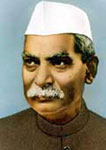|

Dr. Rajendra Prasad, son of Mahadev Sahai, was born in
Zeradei village in Bihar on December 3, 1884. Rajen was
a brilliant student throughout school and college. He
stood first in the entrance examination of the
University of Calcutta and was awarded a Rs. 30 per
month scholarship. It was first time that a student from
Bihar had excelled. He joined the Calcutta Presidency
College in 1902.
In 1915, Rajen passed the Masters in Law examination
with honors, winning a gold medal. He then completed his
Doctorate in Law to attain the title, Dr. Rajendra
Prasad.
Whenever the people suffered, Dr. Prasad was present to
help reduce the pain. In 1914 floods ravaged Bihar and
Bengal. Dr. Prasad became a volunteer distributing food
and cloth to the flood victims. In 1934, Bihar was
shaken by an earthquake. The quake caused immense damage
and loss of property. The quake was followed by floods
and an outbreak of malaria. Dr. Prasad dove right in
with relief work, collecting food, clothes and medicine.
In 1935, an earthquake hit Quetta. Dr. Prasad was not
allowed to lend a hand because of Government
restrictions. He did not rest. He set up relief
committees in Sind and Punjab for the homeless victims
that flocked there.
Dr. Prasad presided over the Bombay session of the
Indian National Congress in October 1934. Following the
resignation of Subhash Chandra Bose as the President of
the Congress in April 1939, Dr. Prasad was elected
President. He did his best to heal the rifts created
between the incompatible ideology of Subhash Chandra
Bose and Gandhiji. Rabindranath Tagore wrote to Dr.
Prasad, "I feel assured in my mind that your personality
will help to soothe the injured souls and bring peace
and unity into an atmosphere of mistrust and chaos..."
As the freedom struggle progressed, the dark shadow of
communalism which had always lurked in the background,
steadily grew. To Dr. Prasad's dismay communal riots
began spontaneously burst all over the nation and in
Bihar. He rushed from one scene to another to control
the riots. Independence was fast approaching and so was
the prospect of partition. Dr. Prasad, who had such fond
memories of playing with his Hindu and Muslim friends in
Zeradei, now had the misfortune of witnessing the nation
being ripped into two.
On August 15, 1947 India was free. Earlier, a
Constituent Assembly was formed in July 1946, to frame
the Constitution of India and Dr. Rajendra Prasad was
elected its President. On November 26, 1946 the
Constitution of India was completed and accepted by the
people of India. On January 26, 1950, the Constitution
was ratified and Dr. Rajendra Prasad was elected the
first President of India. Dr. Prasad transformed the
regal splendor of Rashtrapati Bhavan into an elegant
"Indian" home. Dr. Prasad visited many countries on
missions of goodwill. He stressed for peace in a nuclear
age. In 1962, after 12 years as President, Dr. Prasad
retired. He was awarded the highest civilian award of
India, the Bharat Ratna. Dr. Prasad authored many books
including his autobiography "Atmakatha" (1946),
"Satyagraha at Champaran" (1922), "India Divided"
(1946), "Mahatma Gandhi and Bihar, Some Reminisences"
(1949), and "Bapu ke Kadmon Mein" (1954).
Dr. Prasad spent the last few months of his life at the
Sadaqat Ashram in Patna. He died on February 28, 1963.
|